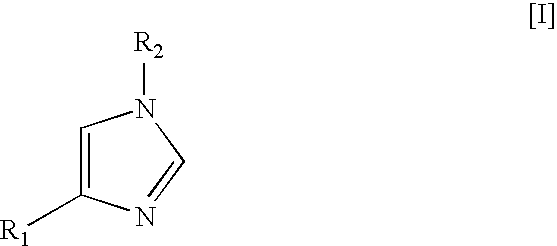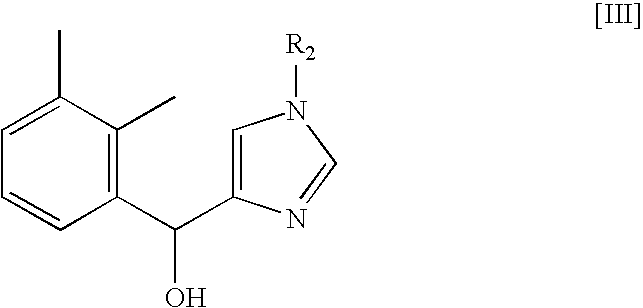Method for preparing medetomidine and its salts.
a technology of medetomidine and salt, which is applied in the field of preparing medetomidine and its salt, can solve the problems of low yield of medetomidine, and achieve the effects of increasing the yield of the product, and reducing the risk of contamination
- Summary
- Abstract
- Description
- Claims
- Application Information
AI Technical Summary
Benefits of technology
Problems solved by technology
Method used
Image
Examples
example 1
Step A
Preparation of (2,3-Dimethylphenyl)-(3-trityl-3H-imidazol-4-yl)methanol
[0020]A solution of isopropylmagnesium bromide in tetrahydrofuran (48 mL, 0.046 mol) was added to a stirred solution of 4-iodo-1-trityl-1H-imidazole (19.0 g, 0.046 mol) in dichloromethane (180 mL) at 10 to 15° C. The reaction mixture was allowed to warm to the ambient temperature and was stirred at ambient temperature for 1 hour. The reaction mixture was then cooled to 10-15° C., at which point a solution of 2,3-dimethylbenzaldehyde (6.2 mL, 0.046 mol) in dichloromethane (10 mL) was added, while not exceeding 20 to 25° C. After additional stirring for 1 hour at ambient temperature a 10% aqueous ammonium chloride solution (200 mL) was added to the reaction mixture. The organic layer was separated and washed with an aqueous sodium chloride solution (150 mL), thereafter the organic layer was concentrated to a volume of 40 mL.
[0021]A precipitate of (2,3-dimethylphenyl)-(3-trityl-3H-imidazol-4-yl)methanol was ob...
example 2
Step b
Preparation of (2,3-dimethylphenyl)-(3-trityl-3H-imidazol-4-yl)methanone
[0023]2,3-Dimethylphenyl)-(3-trityl-3H-imidazol-4-yl)methanol (248 g, 0.558 mol) was added to stirred dichloromethane (5000 mL) in a 10-liter glass reactor, fitted with a reflux condenser and a thermometer. Thereafter manganese (IV) oxide (305 g, 3.51 mol) was added to the reaction mixture. The reaction mixture was heated at reflux for 2 hours at 40° C. The precipitate of manganese oxides was separated by filtration; the damp cake on the filter was washed with dichloromethane (700 mL).
[0024]The clear filtrate was poured into a 10-liter glass reactor, fitted with a stirrer, a distillation condenser and a thermometer. The reaction mixture was stirred while dichloromethane was distilled off at 40° C. Thereafter 96% ethanol (1000 mL) was added to the reaction mixture and the residual dichloromethane was removed by distillation at 50 to 55° C.
[0025]The reaction mixture was stirred and cooled to −1 to −3° C. The...
example 3
Step c
Preparation of 1-(2,3-dimethylphenyl)-1-(3-trityl-3H-imidazol-4-yl)ethanol
[0026](2,3-Dimethylphenyl)-(3-trityl-3H-imidazol-4-yl)methanone (216 g, 0.488 mol) was added to stirred tetrahydrofuran (3000 mL) in a 6-liter glass reactor fitted with a mechanical stirrer, a thermometer, a dropping funnel and a tube for argon introduction into the reaction mixture.
[0027]A methylmagnesium chloride solution in tetrahydrofuran (190 mL, 0.584 mol) was added dropwise to the reaction mixture at 0° C. under an argon atmosphere. The reaction mixture was maintained at 0° C. After addition of a methylmagnesium chloride solution the reaction mixture was warmed to 25° C. over 3.5 hours, at which point 10% aqueous ammonium chloride solution (90 mL) was added to the reaction mixture. The organic layer was separated and washed with saturated sodium chloride solution (700 mL). The organic layer was concentrated in vacuo to 20% of the original volume; the residue was cooled and allowed to crystallize a...
PUM
| Property | Measurement | Unit |
|---|---|---|
| temperature | aaaaa | aaaaa |
| temperature | aaaaa | aaaaa |
| temperature | aaaaa | aaaaa |
Abstract
Description
Claims
Application Information
 Login to View More
Login to View More - R&D
- Intellectual Property
- Life Sciences
- Materials
- Tech Scout
- Unparalleled Data Quality
- Higher Quality Content
- 60% Fewer Hallucinations
Browse by: Latest US Patents, China's latest patents, Technical Efficacy Thesaurus, Application Domain, Technology Topic, Popular Technical Reports.
© 2025 PatSnap. All rights reserved.Legal|Privacy policy|Modern Slavery Act Transparency Statement|Sitemap|About US| Contact US: help@patsnap.com



